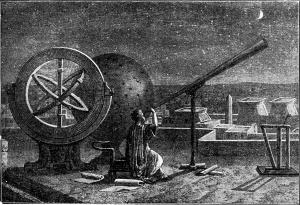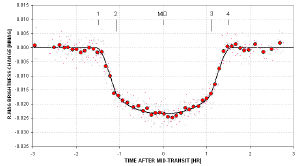Blog
Missed Connections
24 October 2014
 Hermann Göll (1876)
Hermann Göll (1876)Typically in astronomy we award credit of discovery to whomever identifies an object and recognizes what it is (or at least recognizes it’s something strange). But once the dust has settled, we can sometimes look back on earlier observations and find that someone else saw it first, but didn’t recognize its importance. If we gave credit to the first observer, some astronomical history would be very different.
Take, for example, the planet Uranus. It’s discovery is typically attributed to William Herschel, who observed it in 1781 and initially thought it was a comet. He later determined that it’s motion was more planetary, and Uranus became the first planet beyond one known throughout history. But interestingly, Uranus can be observed with the naked eye. There is some evidence that the Greek astronomer Hipparchus observed it as a faint star. English astronomer John Flamsteed observed it half a dozen times in 1690, also labeling it as a star. Herschel wasn’t remotely the first observer of Uranus, he just proved what it was.
You can see a similar process in the discovery of cosmic expansion. Credit for this is usually given to Edwin Hubble, who demonstrated that there was a correlation between the Doppler shift of galaxies and their distances, now known as Hubble’s law. But the galactic Doppler shifts weren’t measured by Hubble. Most of them were measured by Vesto Slipher. Hubble did measure the distances of galaxies, but used a method developed by Henrietta Leavitt. Hubble did put two and two together, but he wasn’t the first to observe the effect of cosmic expansion. Of course, from cosmic expansion one is led to the idea of the big bang. One of the first strong bits of evidence for the big bang was the cosmic microwave background, the thermal afterglow of that primeval event. Credit for the CMBs discovery goes to Arno Penzias and Robert Wilson, who measured the microwave glow in the mid 1960s. But in 1955 Émile Le Roux observed the microwave background, and in 1957 Tigran Shmaonov made a similar discovery. Shmaonov determined the temperature as being about 4 Kelvin, and Le Roux estimated it to be 3 Kelvin. But neither connected their observations to the big bang model.
 Bruce L. Gary
Bruce L. GaryExoplanets are another area of missed observations. Credit for the first discovery of an exoplanet goes to Aleksander Wolszczan and Dale Frail for the observation of two planets orbiting a pulsar. A clear observation of an exoplanet was made 4 years earlier by Bruce Campbell, G. A. H. Walker, and Stephenson Yang. Their observations of Gamma Cephei indicated the presence of a planet, but their conclusion was tentative and the planet wasn’t confirmed until 2002. There are several transiting exoplanets that can be observed by amateur astronomers with mid-size telescopes. If we had known where to look exoplanets could have been discovered decades earlier.
In fact, a recent paper on the arxiv discusses the first documented evidence for exoplanets, dating back to 1917.1 Credit for that first discovery should go to Adriaan van Maanen, most famous for claiming that spiral “nebulae” rotated quickly and couldn’t be galaxies. He observed the presence of heavy elements in the spectra of a white dwarf star. Since white dwarfs don’t have heavy elements in their spectra, this indicates the presence of a debris field orbiting the star. Of course van Maanen had no way of knowing this, or even what a white dwarf really was.
Hindsight is 20/20, as the saying goes. Sometimes even the best of us miss a discovery, even when it’s right in front of us.
Zuckerman, B. “Recognition of the first observational evidence of an extrasolar planetary system.” arXiv preprint arXiv:1410.2575 (2014). ↩︎